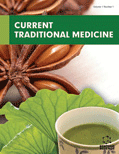Abstract
Ancient systems of medicine such as Ayurveda and others in India have contributed vast knowledge to develop herbal medicines over the years. The WHO has also recognized the importance of drugs developed from natural products. Sida rhombifolia Linn. known as ‘Mahabala’ is ethnomedicinal plant of Malvaceae. Traditionally S. rhombifolia was used in India in the form of extracts/powder/paste by tribal populations in India for treating common ailments like cough and cold, fever, stomach, kidney and liver disorders, inflammations, etc. The present review describes a detailed overview of traditional medicinal uses, phytochemistry and ethnopharmacological studies of S. rhombifolia. Several phytoconstituents from S. rhombifolia have been reported to exhibit pharmacological activities in vivo and/or in vitro bioassays. Validation of ethnomedicinal uses of medicinal plants by modern scientific approaches is essential for ensuring safe and effective utilization of herbal medicines.
Keywords: Sida rhombifolia, ethnomedicine, ayurveda, pharmacological activity, phytoconstituents, mahabala.
[http://dx.doi.org/10.1007/s11101-019-09629-9]
[http://dx.doi.org/10.3389/fphar.2010.00008] [PMID: 21713103]
[http://dx.doi.org/10.1089/jmf.2006.129] [PMID: 18158841]
[http://dx.doi.org/10.3390/ijms12074661] [PMID: 21845103]
[http://dx.doi.org/10.1016/j.etp.2010.02.010] [PMID: 20303721]
[http://dx.doi.org/10.1016/j.jep.2010.08.037] [PMID: 20728516]
[http://dx.doi.org/10.4103/0975-1483.57070]
[http://dx.doi.org/10.1080/13880209.2017.1285322] [PMID: 28152649]
[http://dx.doi.org/10.4314/thrb.v20i4.4]
[http://dx.doi.org/10.4172/2329-6836.1000101]
[http://dx.doi.org/10.1186/1472-6882-10-40] [PMID: 20663208]
[http://dx.doi.org/10.1002/ptr.1294] [PMID: 13680839]
[http://dx.doi.org/10.2307/4115855]
[http://dx.doi.org/10.2307/4107959]
[http://dx.doi.org/10.3923/jbs.2009.504.508]
[http://dx.doi.org/10.3390/molecules18032769] [PMID: 23455668]
[http://dx.doi.org/10.1055/s-2007-971529] [PMID: 17402065]
[http://dx.doi.org/10.3390/medicines4040075] [PMID: 29057840]
[http://dx.doi.org/10.3390/molecules22010094] [PMID: 28067836]
[http://dx.doi.org/10.1002/cbdv.200790180] [PMID: 17886841]
[http://dx.doi.org/10.7897/2230-8407.1010309]
[http://dx.doi.org/10.3109/08923973.2011.605142] [PMID: 21970621]
[http://dx.doi.org/10.1016/j.etap.2010.01.003] [PMID: 21787606]
[http://dx.doi.org/10.31557/APJCP.2022.23.11.3677] [PMID: 36444580]
[http://dx.doi.org/10.19026/bjpt.4.5386]
[http://dx.doi.org/10.1016/j.yrtph.2021.104974] [PMID: 34139276]
[http://dx.doi.org/10.5530/jams.2017.2.34]
[http://dx.doi.org/10.1556/JPC.18.2005.5.5]
[http://dx.doi.org/10.1177/1934578X0800300508]
[http://dx.doi.org/10.4103/ayu.AYU_49_16] [PMID: 29200752]
[http://dx.doi.org/10.1002/bmc.5479] [PMID: 35961325]































